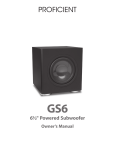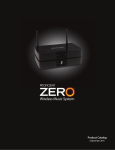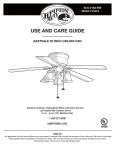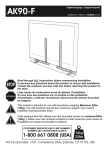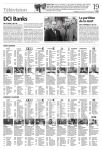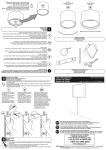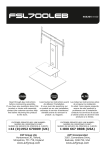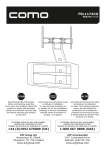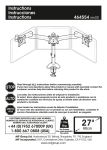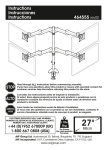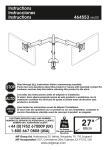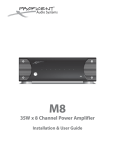Download PROFICIENT ONE
Transcript
PROFICIENT ONE Universal IR Kit Owner’s Manual DESCRIPTION Proficient One is a universal IR Receiver Kit that can be adapted to almost any surface mount, flush mount or shelf mount application. It includes all of the parts necessary for installing a single-room IR Repeater System for controlling a TV, Audio/Video Receiver, Blu-ray player, Cable Box, Satellite Receiver...just about any IR controlled A/V home entertainment device. The kit includes an IR Receiver that can be attached to the front of a TV, or extended from behind on flat panel TVs that have a minimal frame around the display area. The receiver can also be adapted to a low-profile shelf-top case or cabinet door adapter for controlling IR components hidden in an equipment cabinet. The Proficient One IR Receiver adapts and connects in minutes! Please read the instructions in this manual carefully to enjoy arm chair control of your favorite audio/video components! FEATURES • IR Receiver shelf mount, flush mount, surface mount and TV mount adapters allow installation almost anywhere • IR Receiver compatible with most Plasma, LCD and LED TVs • IR Receiver compatible with most CFL light bulbs • Includes one IR Router, one IR Power Supply, and two IR Dual Flashers for easy system installation SPECIFICATIONS • Infrared carrier frequency bandwidth: 30 - 60 kHz • Reception range: Up to 80 feet* • Reception angle: +/- 45º • Cable requirements: See section: Extending The Receiver Wire • Max. Transmission length: 1 mile using 18 gauge wire • Maximum current output: 100mA • IR Receiver Dimensions: .55" diameter (14mm) • Power requirements: +12VDC, 100mA * Depending on remote control output strength and ambient conditions. 2 WHAT’S INCLUDED 1 - Proficient One IR Receiver 1 - Tabletop Adapter 1 - Flush Mount Adapter 1 - TV Mount Adapter 1 - IR Router 2 - Dual IR Flashers 1 - IR Power Supply 1 - BOT-1.0 IR Terminal 1 - PTP-1 Plug to Plug Jumper 1 - IR Parallel Block 3 READ THIS BEFORE YOU DO ANYTHING! FOUR IMPORTANT CONSIDERATIONS 1. Where is the IR Receiver going to be located? The IR Receiver must be ‘line-ofsight’ to the remote control being used to be able to control the system audio/video components. This location should be in a convenient spot in front of the user when seated in a typical location for watching TV or listening to music. This will determine how the IR Receiver is going to be mounted. 2. How is the IR Receiver going to be mounted? The IR Receiver can be surface mounted directly to the frame on the front of some flat panel TVs. For TVs that do not have a wide enough frame, the TV Mount Adapter can be used to extend the IR Receiver out from the back or side of the TV. If the IR Receiver is going to be mounted in a cabinet door, the Flush Mount Adapter will mount the IR Receiver in an 11/16" hole in the cabinet door. If the IR Receiver is going to be placed on a shelf or on top of a cabinet, the Tabletop Adapter provides an attractive, low profile case for that application. 3. Where are the audio/video components that are going to be controlled? The IR Receiver, Flashers and Power Supply all connect to the IR Router. The IR Router should be in the same location as the audio/video components. If the A/V components are in a wall unit or cabinet in the same room and within a few feet of the IR Receiver, then once the IR Receiver has been mounted, find a convenient location that allows access to the IR Router for making connections and then simply connect the IR Receiver, Flashers and Power Supply. (The IR Receiver has a total wire length of 6 feet, 8 inches, and the Flashers have a wire length of 8 1/2 feet, usually enough wire to make connections in a typical cabinet or wall unit.) If the IR Receiver is going to be mounted across the room or in a different room from the A/V components, the wire length of the IR Receiver can be extended to accommodate those situations. Please see the section: Extending the Receiver Wire for additional information. 4. IMPORTANT NOTE - Placement - The IR Receiver should be located so that it is not directly facing a light source such as sunlight, lamps or video displays (CRT, LCD, and Plasma). When mounted near a display, it should be flush to the display and away from light reflections that may occur. With answers to these three important questions, you’re ready to install your Proficient One IR Receiver...So let’s go! 4 INSTALLING THE IR RECEIVER Front of TV Attach with Adhesive Attach with Adhesive To IR Router RCVR Jack PROFICIENT ONE IR Receiver PROFICIENT ONE Electronics Module 8” Receiver Cable Diagram 1 - Surface Mount - Flat Panel TV SURFACE MOUNT The first, and easiest option, is to mount the IR Receiver on the front frame of a flat panel TV. This application can also be used to surface mount the IR Receiver to other objects. 1. Select a location on the TV frame to mount the IR Receiver. Be sure the receiver will not be blocked by any object to allow ‘line-of-sight’ to the remote control in normal use. 2. With the IR Receiver 8" Receiver Cable directed toward the edge of the TV, using one of the included adhesive strips, carefully attach the IR Receiver to the TV frame. Diagram 1 3. Carefully flatten and wrap the 8" Receiver Cable around to the back of the TV. The Receiver Cable can be secured to the TV with tape or a wire holder if necessary. Do not block any TV vents. 4. Using one of the round adhesive strips, carefully attach the Electronics Module to the rear of the TV. Do not block any TV vents. 5. Carefully run the plug end of the Receiver Cable into the cabinet with the A/V components to where the IR Router will be located. Be careful not to pinch or strain the Receiver Cable. The Receiver Cable can be secured to the back of the TV with tape or a wire holder. Do not block any TV vents. If this is your application, when finished, proceed to section: Typical Connections. 5 INSTALLING THE RECEIVER Front of TV Attach with Adhesive Flat End Attach with Adhesive PROFICIENT ONE Electronics Module To IR Router RCVR Jack PROFICIENT ONE TV Mount Adapter Attach with Adhesive 8” Receiver Cable PROFICIENT ONE IR Receiver Front of TV PROFICIENT ONE Electronics Module To IR Router RCVR Jack Attach with Adhesive Ridged End Flat End PROFICIENT ONE PROFICIENT ONE IR Receiver TV Mount Adapter Attach with 8” Receiver Cable Adhesive Ridged End Diagram 2 - TV Mount Adapter Rear Mount Diagram 3 - TV Mount Adapter Bottom/Side Mount TV MOUNT ADAPTER The TV Mount Adapter allows mounting the IR Receiver on an extension attached to the rear or side of a flat panel TV that does not have a frame on the front that is wide enough to directly mount the IR Receiver. This application can also be used to mount the IR Receiver in just about any position on just about any object. 360° Both ends of the TV Mount Adapter rotate and swivel allowing the Adapter and IR Receiver to be manipulated into different positions as shown in Diagram 4. 1. Select a location on the TV to mount the TV Mount Adapter. Be sure that once mounted, the IR Receiver will not be blocked by any object to allow ‘line-of-sight’ to the remote control in normal use. 2. With the 8" Receiver Cable aligned to the Wire Gap on the ridged 180° end of the TV Mount Adapter, (Diagram 5) using one of the round, Diagram 4 notched adhesive strips, attach the IR Receiver to the TV Mount Adapter. Flat End Diagrams 2 & 3 3. Using one of the round adhesive strips, attach the flat end of the TV Mount Adapter to the TV frame. Diagrams 2 & 3 & 5 4. Carefully flatten and wrap the 8" Receiver Cable around to the back of the TV. The Receiver Cable can be secured to the TV with tape or a wire holder if necessary. Do not block any TV vents. 5. Using one of the round adhesive strips, attach the Electronics Module to the rear of the TV. Do not block any TV vents. Diagrams 2 & 3 6. Carefully flatten and wrap the plug end of the Receiver Cable into the cabinet with the A/V components. Be careful not to pinch or strain the Receiver Cable. The Receiver Cable can be secured to the back of the TV with tape or a wire holder. Do not block any TV vents. If this is your application, when finished, proceed to section: Typical Connections. 6 Wire Gap Ridged End Diagram 5 INSTALLING THE RECEIVER Receiver Cable Pass-Through Tabletop Adapter Top Inside Base Lock Wide Gap At Top Base Locks Lens IR Receiver Base Lock Electronics Module Socket 8” Receiver Cable IR Receiver Lens Receiver Cable Base Lock Tabletop Adapter Base - Pass-Through Inside Diagram 6 - Tabletop Adapter Insert IR Receiver Electronics Module ‘Bottom Notch’ Base Lock To IR Router RCVR Jack Diagram 7 - Tabletop Adapter Insert Electronics Module TABLETOP ADAPTER The Tabletop Adapter allows mounting the IR Receiver in an attractive low-profile case creating an IR Receiver that can be placed on any shelf or tabletop. Rotate Clockwise to Tighten Lens Rotate Counter-clockwise to Remove 1. Remove the Tabletop Adapter Base by rotating it counter-clockwise as shown in Diagram 8. 2. Position the Tabletop Adapter top so the lens is facing down as shown in Diagram 6. To IR Router RCVR Jack Diagram 8 - Tabletop Adapter Remove/Tighten Base 3. With the 8" Receiver Cable on the IR Receiver facing up, carefully insert the IR Receiver into the socket on the backside of the lens as shown in Diagram 6. The receiver should snap into place when properly inserted. 4. With the ‘bottom notch’ of the Electronics Module facing you, carefully slide the module onto the post in the Electronics Module Socket as shown in Diagram 7. 5. Carefully wrap the 8" Receiver Cable around the Electronics Module and extend the plug end of the Receiver Cable out of the Tabletop Adapter case via the Receiver Cable Pass Through as shown in Diagram 7. 6. Align the Adapter Base to the Adapter Top with the ‘wide gap’ aligned at the top with the IR Receiver as shown in Diagram 7. Tighten the base to the top as shown in Diagram 8. If this is your application, when finished, proceed to section: Typical Connections. 7 INSTALLING THE RECEIVER Cabinet Door Cabinet Door Flush Mount Adapter Bezel Push IR Receiver until it snaps into place 11/16” (17.4mm) Diameter Hole 8” Receiver Cable 5/8” (15.9mm) Door Panel Diagram 9 - Flush Mount Adapter 11/16" Hole Diagram 10 - Flush Mount Adapter Install IR Receiver FLUSH MOUNT ADAPTER The Flush Mount Adapter allows mounting the IR Receiver in an equipment cabinet door. This allows IR controlled audio/video components to be controlled with the cabinet door closed. This application requires drilling an 11/16" (17.4mm) hole in the cabinet door as shown in Diagram 9. It is recommended that the IR Receiver be mounted closer to the hinged side of the cabinet door so the Electronics Module can be mounted to an inside wall rather than the door. 1. Select a location on the cabinet door to mount the Flush Mount Adapter. Be sure to leave adequate clearance from the back of the cabinet door to the front of the A/V components to allow room for the Adapter Locks with the door closed. (Diagram 12) Also be sure that once mounted, the IR Receiver will not be blocked by any object to allow ‘line-of-sight’ between the remote control and the IR Receiver in normal use. 2. Drill an 11/16" (17.4mm) diameter hole in the cabinet door. Diagram 9 3. From the back side of the cabinet door, feed the IR Receiver through the hole in the cabinet door. Carefully pull the 8" Receiver Cable straight back from the IR Receiver and with the receiver lens oriented to match the orientation of the adapter (thick sections 12 and 6 o’clock) push the IR Receiver into the back of the adapter until it snaps into place. Diagram 10 4. Pinch the Adapter Locks together and carefully slide the adapter/receiver assembly through the hole until the adapter bezel is pressed against the front of the cabinet door. Be sure to align the thick sections of the bezel at 12 and 6 o’clock for best left to right off-axis performance. (It will look better that way as well.) Diagram 11 8 INSTALLING THE RECEIVER Pinch Adapter Locks together so they will slide through hole in cabinet door Cabinet Door 11/16” (17.4mm) Diameter Hole Cabinet Door 8” Receiver Cable 8” Receiver Cable Adapter Bezel Leave adequate space between the Adapter Locks and the A/V components with the cabinet door closed. Diagram 11 - Flush Mount Adapter Install Adapter Diagram 12 - Flush Mount Adapter Adapter Installed 5. NOTE: It is recommended that the Electronics Module be mounted to an inside wall of the cabinet. If attached with adhesive, there is some possibility that if mounted to the door, in time, the module could come loose from the action of the door opening and closing and ultimately fall off, potentially damaging the IR Receiver the Electronics Module or both. Using an appropriate length wood screw (not included) attach the Electronics Module to an inside wall of the cabinet. Use a screw that will secure the module but will not penetrate the outside wall of the cabinet. Do not overtighten the screw to avoid damaging the Electronics Module case. Diagram 13 OR... Use one of the included adhesive strips to attach the Electronics Module to the inside of the cabinet. 6. Carefully run the plug end of the Receiver Cable to where the IR Router will be located. Be careful not to pinch or strain the cable. If this is your application, when finished, proceed to section: Typical Connections. 9 Cabinet Door Flush Mount Adapter Bezel 8” Receiver Cable Use wood screw or adhesive to attach Electronics Module to back of cabinet door or inside wall of cabinet. Electronics Module To IR Router RCVR Jack Diagram 13 - Flush Mount Adapter Secure Electronics Module TYPICAL CONNECTIONS DVD To extend wire length, cut here. Electronics Module Proficient One IR Receiver mounts directly on a flat panel TV frame or to one of the included TV, Tabletop or Flush Mount Adapters PROFICIENT ONE IR Reciver Remote Control Cable IR Dual Flasher IR Flasher w/red LED A/V Receiver IR Power Supply PTP-1.0 12VDC Regulated 500mA To 120V AC (unswitched) IR Router PTP-1.0 Plug to Plug Jumper Cable Diagram 14 - Typical Connections SINGLE ROOM - EQUIPMENT CABINET With the IR Receiver configured and installed in a surface mount, TV mount, flush mount or tabletop application as described on the previous pages, install the IR Router and then connect the IR Receiver, Flashers and Power Supply to the IR Router as described below. 1. Find a convenient location in the equipment cabinet to mount the IR Router. This location should allow easy access for making connections and be located so the IR Receiver, Flasher and Power Supply wires can all be connected without modification. Attach the IR Router to a cabinet wall or shelf with the included adhesive strip or wood screws. Be sure the screws are long enough to secure the Router but not so long that they extend out of the side of the cabinet. 2. Connect the IR Receiver to the “IR RCVR” jack on the IR Router. 3. Carefully position one IR Flasher over the IR Eye on each audio/video component to be controlled. (If the eye is not obvious, shine a small flashlight into the front panel of the component to locate the eye, or refer to the component’s owner’s manual.) 4. Position the IR Flasher so the mini-wire is positioned toward the nearest top or bottom edge on the component being controlled. 5. Carefully wrap the Flasher mini-wire around to the back of the component and run the Flasher wire to the IR Router, being careful to not pinch the wire between components. 6. Connect the Dual Flasher to one of the “IR Flashers” jacks on the IR Router . Repeat for all Flashers. 10 TYPICAL CONNECTIONS 7. As an option, use the PTP-1 Plug to Plug Jumper Cable to connect a Flasher OUT on the IR Router to a device with a 3.5mm mini IR IN jack. If it doesn’t work, use an IR Flasher for IR control. 8. Connect the IR Power Supply to the “12VDC Regulated” jack on the IR Router. Connect the Power Supply to an UNSWITCHED AC outlet. 9. To test, point an IR Remote at the Proficient One IR Receiver. Press a specific function button on the remote (Cable/Satellite ON/OFF for example). All connected Flashers should flash red, and the selected component should respond to the command (Cable/Satellite ON/OFF). If any of that didn’t happen, check IR system connections and try again. If the system still hasn’t responded, check the Troubleshooting section at the end of this manual. EXTENDING THE RECEIVER WIRE In some applications it may be necessary to extend the IR Receiver wire. Typical examples would be if the IR Receiver is going to be located across the room from the IR Router and A/V components or if the IR Receiver is going to be located in a remote room. This will give the user the ability to control IR controlled audio/video components from a location where the remote control no longer has direct line-of-sight to the equipment. To extend the IR Receiver wire, use the included BOT-1.0 IR Terminal as shown in Diagram 17 or the IR Parallel Block as shown in Diagram 18. Use unshielded, 3-conductor stranded wire as detailed in the Wire Length/Gauge Table on the next page. IMPORTANT NOTE: DO NOT EXTEND THE WIRE LENGTH BETWEEN THE IR RECEIVER AND THE ELECTRONICS MODULE. THIS WILL REDUCE THE SENSITIVITY OF THE IR RECEIVER AND VOID THE WARRANTY. IF IT IS NECESSARY TO EXTEND THE WIRE LENGTH TO THE IR ROUTER WITHOUT USING THE BOT-1.0 IR TERMINAL, EXTEND THE WIRE THAT RUNS BETWEEN THE ELECTRONICS MODULE AND 3.5MM MINI PLUG (DIAGRAM 15). SEE DIAGRAM 16 FOR THE WIRE PIN-OUT OF THE RECEIVER WIRE. USE THE IR PARALLEL BLOCK TO MAKE CONNECTIONS AS SHOWN IN DIAGRAM 18. Do not cut to extend wire length Cut this section to extend wire length Electronics Module Diagram 15 - Only Extend The Plug End of the IR Receiver Cable 11 TYPICAL CONNECTIONS Use unshielded, 3 conductor stranded wire per the table, when extending the plug end of the IR Receiver Cable. (4 conductor provides an extra wire for back-up if one of the conductors gets damaged.) IR WIRE LENGTH IR WIRE GAUGE UP TO 200’ (61m) 24 AWG UP TO 600’ (183m) 22 AWG UP TO 2000’ (610m) 20 AWG UP TO 5000’ (1524m) 18 AWG GOLD = +12V GND (RING) RED = GND +12VDC (SLEEVE) IR SIGNAL (TIP) BLUE = IR Diagram 16 - 3.5mm Stereo Mini Plug & Wire Pin-Out When adding wire length, as a first option, use the BOT-1.0 (Diagram 17). This will allow complete installation without having to cut the IR Receiver wires. The IR Parallel Block (Diagram 18) has been included as a second option for that type of connection when desirable. Confirm that the IR Signal, +12VDC and GND wires are properly connected to both the BOT-1.0 or IR Parallel Block and the IR Router (Signal to Signal; +12 to +12; GND to GND). Improper connection will affect performance and possibly damage the IR Receiver. The Proficient One Warranty does not cover this type of damage. While it is possible to make wired connections without the BOT-1.0, IR Parallel Block or IR Router, it is not recommended. Their use will reduce installation time, help eliminate errors, allow easy troubleshooting and permit easy system upgrades later, if needed. 8” Receiver Cable (Do Not Add Length!) DVD PROFICIENT ONE IR Receiver Hand Held IR Remote IR Flasher w/red LED Electronics Module IR Dual Flasher BOT-1.0 IR Terminal Cable PTP-1.0 IR Flasher w/red LED A/V Receiver 6’ Reveiver Cable (OK to Add Length) 3-Conductor Extension Cable (unshielded) PTP-1.0 Point to Point Jumper Cable IR Power Supply 12VDC Regulated 500mA REMOTE ROOM To 120V AC (unswitched) MAIN ROOM Diagram 17 - Extending the Plug End of the IR Receiver Cable 12 TYPICAL CONNECTIONS DVD PROFICIENT ONE IR Receiver Electronics Module IR Flasher w/red LED Hand Held IR Remote IR Dual Flasher Cable PTP-1 IR Flasher w/red LED A/V Receiver +12V GND IR 3-Conductor Extension Cable (unshielded) IR Parallel Block PTP-1 Plug to Plug Jumper Cable IR Power Supply REMOTE ROOM 12VDC Regulated 500mA To 120V AC (unswitched) Electronics Module PROFICIENT ONE Hand Held IR Remote IR Receiver MAIN ROOM Diagram 18 - Multi-Room Application MULTI-ROOM APPLICATION Another application is multi-room IR control. If an audio receiver or amplifier is being used to drive speakers in multiple rooms, it may be desirable to place an IR Receiver in some or all of those rooms to control the audio components from another room. In many cases, this same application can be used to control the main zone and second zone of a two-zone A/V Receiver. This will allow a user to turn the system ON/OFF with an IR remote via the IR Receiver(s) in the remote room(s). The system can also be controlled from the main room with an IR remote using the IR Receiver in the main room. Installation combines the connections described in the previous Single Room and Extending the Wire sections. The Main Room IR Receiver gets connected to the ‘IR RCVR’ jack on the IR Router and the multi-room receiver(s) get connected to the screw terminals on the IR Router using either the BOT-1.0 (Diagram 17) or IR Parallel Block (Diagram 18). 13 IR TROUBLESHOOTING GUIDE NOTE: Due to the many variables in a given installation, the troubleshooting measures you may need to take can vary in different situations. Each installation is different due to the number of IR Receivers, length of wire runs, type of wire, amount of ambient IR noise present, etc…. Therefore, your troubleshooting measures for a particular job can range from nothing at all, to any combination of the solutions listed below. Symptom #1: IR Flashers dimly lit or flickering. Cause Solution 1. Signal and ground wires are reversed or shorted either at the IR Router or IR Receiver. Recheck wiring. 2. Defective Flasher. Replace Flasher. 3. Relatively high levels of ambient light noise. This can be due to any of the following: sunlight, florescent lighting or Plasma Displays. Reposition the IR Receiver away from the light source or eliminate the light source. 4. EMI induced noise (electromagnetic interference). This can be due to light dimmer controls or other radiating electronic devices (PC’s or any poorly shielded electronic device). Reposition the IR Receiver and/or cabling away from emitting device. You can also place a 470-ohm resistor in parallel with the IR Signal and GND connections on the IR Router. This will also help alleviate any stray capacitance in the cable. 5. Plasma Interference. Plasma interference can be reflected off of any item it comes into contact with within approx. 3 feet of the front of the display. Keeping this in mind, make sure that the IR Receiver is free from any object that might reflect Plasma interference into the receiving eye. 14 IR TROUBLESHOOTING GUIDE Symptom #2: IR Flashers constantly on. Cause Solution 1. Plasma Interference Plasma interference can be reflected off of any item it comes into contact with within approx. 3 feet of the front of the display. Keeping this in mind, make sure that the IR Receiver is free from any object that might reflect Plasma interference back into the receiving eye. 2. Voltage and Ground wires are reversed at the IR Router or IR Receiver Recheck wiring. 3. Relatively high levels of ambient noise. This can be due to any of the following: sunlight, florescent lighting or Plasma Displays. Reposition the IR Receiver or eliminate the light source. 4. EMI induced noise (electromagnetic interference). This can be due to light dimmer controls or other radiating electronic devices (PC’s or any poorly shielded electronic device). Reposition the IR Receiver and/or cabling away from emitting device. You can also place a 470-ohm resistor in parallel with the IR Signal and GND connections on the IR Router. This will also help alleviate any stray capacitance in the cable. 5. Power Supply not putting out proper voltage. Verify supply is a 12VDC regulated supply reading between 11.5 to 13VDC under load. Use the included 12VDC Regulated, 500mA Power Supply. 15 IR TROUBLESHOOTING GUIDE Symptom #3: Intermittent IR control (i.e. buttons on remote need to be pressed multiple times) Cause Solution 1. Plasma Interference. Plasma interference can be reflected off of any item it comes into contact with within approx. 3 feet of the front of the display. Keeping this in mind, make sure that the IR Receiver is free from any object that might reflect Plasma interference back into the receiving eye. 2. Relatively high levels of ambient noise. This can be due to any of the following: sunlight, florescent lighting or Plasma Displays. Reposition the IR Receiver or eliminate the light source. 3. Long Wire Runs – shielded wire typically of 100 feet (30 meters) or longer causes a filter effect due to accumulated capacitance of the wire. Intermittent, or no IR control, could actually be because of the longer wire runs. Putting a 470-ohm resistor in parallel at the IR Router between signal and ground will effectively discharge the capacitance of the wire. Adding a resistor between the input and ground of the IR Router will drop the IR level down somewhat. A non-amplified connecting block, such as the IR Router, may not have enough signal output for consistent control of the equipment. 4. Low batteries in Remote Replace batteries. 5. Flasher placement is correct but the signal is overpowering the unit or there is bleed-through from other Flashers close by. If the A/V source (i.e. cable box, DVR or satellite box) sees the IR signal twice, the source will not process it correctly. Place a piece of black electrical tape over the Flasher to block reflected IR signals. 16 IR TROUBLESHOOTING GUIDE Symptom #4: IR Flashers flash but some (or all) components do not respond. Cause Solution 1. Flasher placement is incorrect. Reposition the Flasher so that it is directly over the component’s IR eye. Shine a small flashlight into the front panel of the component to locate the eye or consult the component’s owner’s manual for the exact location of the IR eye. 2. Flasher placement is correct but the signal is overpowering the unit or there is bleed-through from other Flashers close by. Reposition the Flasher so it is not directly over the IR eye to reduce the amount of IR signal the IR eye on the component being controlled ‘sees’. If the A/V source (i.e. cable box, DVR or satellite box) sees the IR signal twice, the source will not process it correctly. Place a piece of black electrical tape over the Flasher to block reflected IR signals. 17 IR TROUBLESHOOTING GUIDE Symptom #5: Absolutely No Functionality (How to determine which component is at fault) Component to Test Instructions 1. Verify Power Supply With a Multimeter, measure the DC Voltage of the Power Supply while it is connected to the IR Router. Put the negative lead of the meter on the terminal marked GND and the positive lead on the terminal marked 12VDC (or V). You should get a reading between 11.5VDC and 13.0VDC. If not, remove the supply from the IR Router and measure again - this time directly on the 2.5mm coaxial plug. If it reads between 11.5VDC and 13VDC, the Power Supply is most likely good. Reconnect to the IR Router and proceed to Step 2. NOTE: In most cases this will indicate the Power Supply is good but in some cases the Power Supply can still be bad (i.e. reads good when not plugged in but may not be able to handle the current load of the system.) 2. Verify Flasher. (Proficient Dual-Visible IR Flasher) Remove the Power Supply from the IR Router and all Flashers from the output. Place a jumper wire on the IR Router between IR and +12V. Reconnect the Power Supply and one Flasher. The Flasher should light bright and solid. Repeat for all Flashers. 18 NOTES 19 LIMITED LIFETIME WARRANTY Proficient Audio Systems (“Proficient”) warrants to the original retail purchaser only (“you”) that this product will be free from defects in materials and workmanship for life (the “Warranty Period”), subject to the limitations and exclusions set out in this Limited Warranty. This warranty is not transferable to subsequent owners of the product. If you discover a defect in material or workmanship within the Warranty Period, you can obtain warranty service by contacting Proficient during the Warranty Period at 800.472.5555 or techsupport@ proficientaudio.com or by sending the product to Core Brands at 12471 E. Riverside Drive, Eastvale, CA 91752 or to the dealer from whom you purchased the product. Defective products must be shipped, prepaid and insured, together with proof of purchase. Warranty service requests made without proof of date of purchase will be denied. Freight collect shipments will be refused. It is preferable to ship this product in the original shipping container to lessen the chance of transit damage. In any case, the risk of loss or damage in transit is to be borne by the purchaser. If, upon examination by Proficient or its authorized dealer, it is determined that the unit is in fact defective, Proficient will, at its option: • Repair or replace the product at no additional charge; or • If the model is no longer available and can not be repaired effectively, replace the unit with a current model of equal or greater value. In some cases where a new model is substituted, a modification to the mounting surface may be required. If mounting surface modification is required, Proficient assumes no responsibility or liability for such modification. Proficient will bear the cost of returning the repaired or replaced product to you, freight prepaid. All replaced parts and product become the property of Proficient Audio Systems. The foregoing is your sole and exclusive remedy for breach of warranty. If the product is not found to be defective, Proficient will contact you to arrange for return of the product to you, at your expense. EXCLUSIONS: • This Warranty does not include service or parts to repair damage caused by accident, disaster, misuse, abuse, negligence, inadequate packing or shipping procedures, commercial use, voltage inputs in excess of the rated maximum of the unit, or service, repair or modification of the product by unauthorized dealers. This Warranty also excludes normal cosmetic deterioration caused by environmental conditions. • This Warranty will be void if: • the Serial Number on the product has been removed, tampered with or defaced. • the product was not purchased from an authorized dealer. THE FOREGOING WARRANTIES ARE EXCLUSIVE AND IN LIEU OF ALL OTHER EXPRESSED AND IMPLIED WARRANTIES. PROFICIENT EXPRESSLY DISCLAIMS ALL SUCH OTHER WARRANTIES, INCLUDING BUT NOT LIMITED TO IMPLIED WARRANTIES OF MERCHANTABILITY, FITNESS FOR A PARTICULAR PURPOSE AND NON-INFRINGEMENT. In no event will Proficient be liable for any incidental or consequential damages arising out of the use or inability to use the product, even if Proficient has been advised of the possibility of such damages, or for any claim by any other party. Notwithstanding the above, if you qualify as a “consumer” under the Magnuson-Moss Warranty Act, then you may be entitled to any implied warranties allowed by law for the Warranty Period. Further, some states do not allow limitations on how long an implied Limited Warranty lasts or allow the exclusion or limitation of consequential damages, so such limitations may not apply to you. ATTENTION TO OUR VALUED CONSUMERS: To insure that consumers obtain quality pre-sale and after-sale support and service, Proficient products are sold exclusively through authorized dealers. Proficient products are not sold online by Proficient or its authorized dealers, and this warranty is VOID if the products have been purchased from any internet reseller. To determine if your Proficient reseller is authorized, please call Proficient at 800.472.5555 or go to proficientaudio.com. For technical inquires, please call 800.472.5555 or e-mail us at [email protected]. 1800 South McDowell Blvd • Petaluma, CA 94954 800.472.5555 • Fax 707.283.5901 • proficientaudio.com ©2014 Core Brands, LLC. All Rights Reserved. Proficient® is a registered trademark of Core Brands, LLC, a Nortek company. 9901331 (Rev A)




















